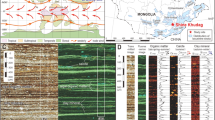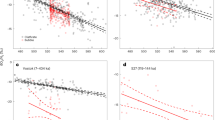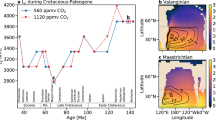Abstract
Recently published analysis of periodicities observed in the characteristics of the annual deposits of a Precambrian (680 Myr ago) lake in South Australia1,2 suggest a physical link between ancient solar variability, surface temperature and cyclicity in varve thickness. Solar-cycle effects on the present climate have remained elusive3. The smaller abundance of molecular oxygen and ozone in the Precambrian atmosphere made it possible for solar ultraviolet radiation to interact directly with the troposphere. In those conditions, global climatic perturbations may have been associated with the 11-year solar cycle. We use a radiative–comvective–photo-chemical model to investigate the sensitivity of the global surface temperature to changes in the ultraviolet solar irradiance. We show that the response maximizes for an O2 atmospheric content of 3 × 10−3 the present atmosphere level. Two alternative hypotheses about the ultraviolet variability are examined. In the first, the solar-cycle variation is restricted to wavelengths below 200 nm. The induced surface temperature fluctuation, δTs, is very small (<0.03 K), except that the amplitude of the ultraviolet modulation is enhanced with respect to average values for solar cycle 21. The second hypothesis assumes that the ultraviolet variability extends up to 300 nm. In this case, a δTs perturbation of several tenths of kelvin is predicted. It is also shown that other local effects such as the amount of water vapour in the troposphere may restrict the conditions in which solar-cycle variations have affected the palaeoclimate.
This is a preview of subscription content, access via your institution
Access options
Subscribe to this journal
Receive 51 print issues and online access
$199.00 per year
only $3.90 per issue
Buy this article
- Purchase on Springer Link
- Instant access to full article PDF
Prices may be subject to local taxes which are calculated during checkout
Similar content being viewed by others
References
Williams, G. E. & Sonett, C. P. Nature 318, 523–527 (1985).
Williams, G. E. Scient. Am. 225, 88–96 (1986).
Pittock, A. B. Q. Jl R. met. Soc. 109, 23–55 (1983).
Chandra, S. J. geophys. Res. 89, 1373–1379 (1984).
Ramanathan, V. J. atmos. Sci. 33, 1330–1346 (1976).
Lacis, A. A. & Hansen, J. E. J. atmos. Sci. 31, 118–133 (1974).
Wang, W. C. & Stone, P. H. J. atmos. Sci. 37, 545–552 (1980).
Sasamori, T. J. appl. Met. 7, 721–729 (1968).
Manabe, S. & Wetherald, R. T. J. atmos. Sci. 39, 1189–1205 (1967).
JPL Publication 85–37 (Pasadena, California, 1985).
Brasseur, G. & Solomon, S. Aeronomy of the Middle Atmosphere (Reidel, Dordrecht, 1984).
Garcia, R. R., Solomon, S. & Roble, R. G. Planet. Space Sci. 32, 411–423 (1984).
Brasseur, G. & Simon, P. C. J. geophys. Res. 86, 7343–7362 (1981).
Kasting, J. F. & Donahue, T. M. J. geophys. Res. 85, 3255–3263 (1980).
Holland, H. D. The Chemical Evolution of the Atmosphere and Ocean (Princeton University Press, 1984).
Willson, R. C., Gulkis, S., Janssen, M., Hudson, H. S. & Chapman, G. A. Science 211, 700–702 (1981).
Hoyt, D. V. & Eddy, J. A. NCAR tech. Note TN-194+STR (1982).
Lindzen, R. S., Hou, A. Y. & Farrell, B. F. J. atmos. Sci. 39, 1189–1205 (1982).
Wang, W. C., Wuebbles, D. J., Washington, W. M., Issacs, R. G. & Molnar, G. Rev. Geophys. 24, 110–140 (1986).
Barron, E. J. & Washington, W. M. J. geophys. Res. 89, 1267–1279 (1984).
Sonett, C. P. & Williams, G. E. J. geophys. Res. 90, 12019–12026 (1985).
Walker, J. C. G. Evolution of the Atmosphere (Macmillan, New York, 1977).
Cloud, P. Mem. geol. Soc. Am. 161, 245–251 (1983).
Crowley, K. D., Duchon, C. E. & Rhi, J. J. geophys. Res. 91, 8637–8647 (1986).
Author information
Authors and Affiliations
Rights and permissions
About this article
Cite this article
Gérard, JC., François, L. A model of solar-cycle effects on palaeoclimate and its implications for the Elatina Formation. Nature 326, 577–580 (1987). https://doi.org/10.1038/326577a0
Received:
Accepted:
Issue Date:
DOI: https://doi.org/10.1038/326577a0
Comments
By submitting a comment you agree to abide by our Terms and Community Guidelines. If you find something abusive or that does not comply with our terms or guidelines please flag it as inappropriate.



